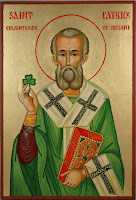The Brazilian PASSION FLOWER grows on a vine and looks like something out of
Carnival. This flower its with colors and frills, inspired the Portuguese missionaries, like St Patrick and the shamrock before them, to use the Passion Flower to help the native understand Christ’s Crucifixion. The frilly filaments symbolize the Crown of Thorns, the top stigma are the Three Nails used to crucify the Lord and the five lower anthers are the wounds in Christ’s hands and feet and side. The blood of Christ is the red stain from the plant. The fragrance of the flower represents the spices prepared by the Holy Women at the tomb. Tea made from the dried Passion Flower induces sleep symbolizing the three days in the tomb and the sweet fruit symbolizes the resurrection and salvation of all peoples.Brazilian SAINT DULCE died March 13, 1992. At the time of her death she was the most well-known women in Brazil. Coming from an upper-class family, Dulce, her name means ‘sweet,’ entered the Franciscan sisters and began giving beggars haircuts and treating their wounds outside the convent door. She found housing for them in abandoned houses in an area called Rat Island. Evicted from there, she housed the sick in an abandoned fish market. Evicted again, she convinced the mother superior to let her use the chicken coop to shelter her patients. The Superior permitted it, as long as Dulce took care of the chickens – she did – by feeding them to the sick and poor! That chicken coop later became San Antonio Hospital. Eighteen years after Dulce’s death her body, and clothing, were found to be incorrupt. Canonized in 2019, St. Dulce’s passion for the salvation of souls flowered in her sweet deeds as she became known as the patron saint of the poor.
March 15 is the feast of a Redemptorist, SAINT CLEMENT HOFBAUER. St. Clement is known for bringing the Redemptorists from Italy across the Alps to Austria and Poland. His generosity is legendary:
We could associate WINTER WHEAT which symbolizes abundance and generosity. Winter Wheat is planted in early Winter so it is ready to reap in the early summer.
In the 5th century, it is said that SAINT PATRICK used
a SHAMROCK as a metaphor to convert the Irish to Christianity. But the Celtic ancients already believed in the triune nature of everything such as the three stages of womanhood: maid, mother, crone; the three elements: earth, water and fire. The shamrock is not the only sign of the Trinity: the Celtic knot also symbolizes the Trinity and that God is intertwined in everything. Legend has it that Patrick designed the image of the Celtic Cross when he placed The Cross into the pagan Sun Wheel to Christianize the eternal cycle of life, death and rebirth with the Cross of Christ’s life, death and resurrection. In seeing the Celtic Cross, our faith leads us to union with the risen Christ and hope in the life to come.The most common flower associated with ST JOSEPH on March 19th and the ANNUNCIATION OF THE LORD on March 25th is the LILY. It is a symbol of innocence; purity and beauty, peace.
Joseph is depicted as holding the infant Jesus and a lily signifying purity and joy.
Likewise, in paintings of the Annunciation, Gabriel is often featured as offering a lily to Mary symbolizing the hope to be fulfilled in the new life she will carry: the Promised One, the Messiah.
When Mary visits Elizabeth she sings her Magnificat. Perhaps she also sang from the prophet Sirach, “Listen to me, faithful ones: open up your petals; Send up the sweet odor like incense; break forth in blossoms like the lily. Raise your voices in a chorus of praise; bless the Lord for all God’s works!” Sirach 39:13-14
Lilies are often associated with funerals where they symbolize that the soul of the departed has been received and restored to innocence after death.
One of my favorite flowers in later Spring is the IRIS. Its name means ‘Sword Lily,’ and its symbolism is taken as an allusion to the sorrow of the Virgin Mary at the Passion of her Son. Remember that Christ’s passion was foretold by Simeon in the Temple when Jesus was just a baby. Simeon blessed the mother and child and prophesized over Mary, saying,
“This child is chosen by God for the destruction and the salvation of many in Israel. He will be a sign from God... And sorrow, like a sharp sword, will break your own heart.” Luke 2:34-35
The beautiful and elegant
iris serves as a symbol of faith and valor in the midst of sorrow. Its varied colors of purple represent the
shades of sorrow that touches all our lives and the graces we have received
from God to stand tall and fast like the iris, like Mary.








No comments:
Post a Comment